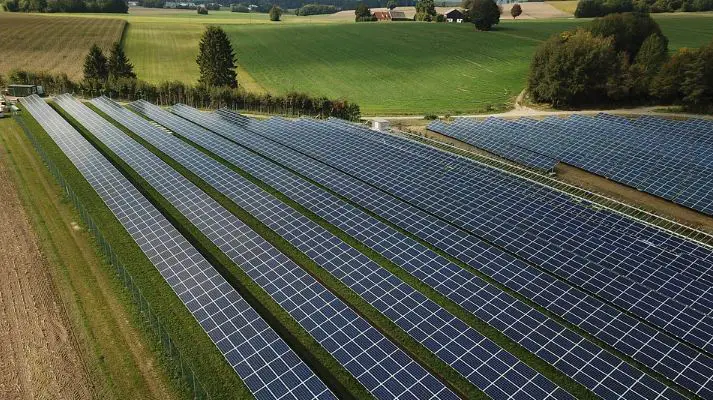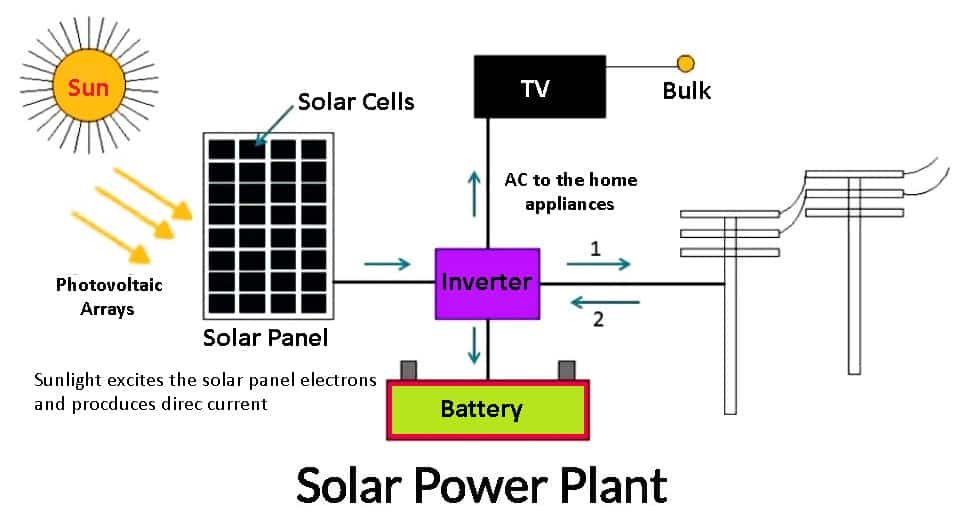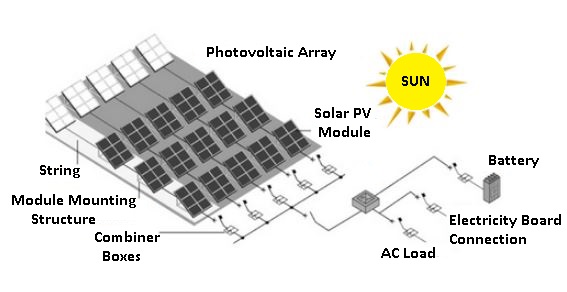Hello readers! In this post, we’ll discuss what is solar power plant? It’s Diagarm, Layout, Working, and More using illustrations.
So let’s start with what is an evaporator.
Introduction
Since fossil fuels won’t last forever, solar power generation seems to be leading the way in clean and renewable energy generation. Almost every home now relies on batteries for power backup.
Solar power plants have been built in China, once thought to be the world’s largest polluter. India further aims to generate 100,000 MW of electricity solely from solar power plants by the year 2023.
Tesla has taken the decision to build a solar power plant that will be the only source of energy for the Hawaiian island of Kauai. For the purpose of storing solar energy for use at night, Tesla is offering its commercial battery packs. They are ensuring they can power the entire island without sunlight for up to three days. Amazingly, it can be recharged after only seven hours of sunlight.
Around the world, the most popular area of research is efficient solar energy production. Let’s see what it takes to turn sunlight into electricity. Before that let’s understand some essential points regarding the solar power plant.
You might like: Different Types of Batteries and Their Applications
Solar Power Plant
Among the various non-conventional sources of energy, solar energy seems to hold out the greatest promise for mankind, as it is freely available, inexhaustible, and non-polluting. Solar power is a form of energy harnessed from the power and heat of the Sun rays. It is renewable and therefore it is a “Green” source of energy.

“A solar power plant is based on converting sunlight into electricity, either directly using photovoltaic or indirectly using concentrated solar power. Concentrated solar power systems use lenses and tracking systems to focus a broad area of sunlight in a small beam”.
Solar power is the cleanest, most reliable form of renewable energy available and it can be used in several forms to help in power supply for residential premises and businesses.
Solar-powered photovoltaic panels convert sun rays into electricity by exciting electrons in silicon cells using photons by the light from the sun.
Read Also: What Are The Different Types of Evaporators?
Meaning of Solar Power
Solar energy is the use of sun energy directly as thermal energy (heat) or through the use of photovoltaic cells in solar and transparent photovoltaic glass to generate electricity.
Now, let’s look at how a solar panel converts sunlight into electricity.
You might like: Different Types of Power Plants and Their Uses Around The World
How does a Solar Panel turn Sunlight into Electricity?
Silicon is a well-known semiconductor with metal and nonmetal properties. To make a solar panel, this silicon is doped with a pentavalent impurity, which converts it to positive-type silicon, also known as p-type silicon. Similarly, the other component is converted to negative or n-type silicon.
As the name implies, the p-type has an excess of holes (positive charge) and the n-type has an excess of electrons. Then these two are combined one on top of the other until they reach the atomic level. Due to their opposite charges and contact, electrons flow from n-type to p-type and holes from p-type to n-type interfere with each other.
The current produced by this charge movement is known as diffusion current. Another important aspect of this potential barrier is that it leads to electric fields that flow from n-type contacts to p-type contacts (the area of potential generation).
Due to this electric field, holes from n-type begin to flow toward p-type, and electrons from p-type begin to flow toward n-type, resulting in a current known as drift current. At first, the diffusion current is greater than the drift current, but as the potential difference grows due to diffusion, the drift current also grows. When diffusion current equals drift current, the current stops flowing.
Conversion of Sunlight
Sunlight arrives on Earth as small energy particles known as photons. When this photon hits the p-type region, it energizes the electron and it flees from the hole. The electric field created by the potential difference at the p-n junction causes electrons to travel to the n-type region, causing current to flow.
But there is something else to know in order for this electric field to be strong enough to travel to the n-type region and not recombine with the hole from which it has been separated.
The n-type and p-type regions are connected to the positive and negative battery terminals, respectively, to strengthen the electric field; this is referred to as the “reverse bias condition.” This increases the likelihood of an electron traveling all the way to the n-type region after being separated from a hole. As a result, the efficiency of a solar panel increases.
Let’s discuss the important components of solar power plants.
Read Also: Types of Condensers and Their Applications
Solar Power Plant Components
Following are the components of solar power plants:
- Solar panels
- Solar cells
- Battery
- D.C. to A.C. Converter (Inverter)
#1 Solar Panels
It serves as the solar power plant’s brain. Solar panels are made up of many solar cells. In one panel, we have about 35 solar cells. Each solar cell produces a very small amount of energy, but when 35 of them are combined, we have enough energy to fully charge a 12-volt battery.
#2 Solar Cells
It serves as the solar power plant’s core. In order to generate energy, a silicon semiconductor is used, which is made up of p-type and n-type silicon semiconductors.
#3 Battery
During the day, batteries are used to produce power and store the excess energy generated during the day, so they can be used at night to supply the energy needed.
#4 D.C. to A.C. Converter (Inverter)
Solar panels generate direct current (D.C.), which must be changed into alternating current (A.C.) before it can be delivered to homes or the power grid.
Solar Power Plant Diagram

You might like: Different Types of A.C Motors and Their Applications
Working of Solar Power Plant
Numerous photons hit the silicon’s p-type region as sunlight passes over solar cells. After absorbing photon energy, an electron and hole pair will separate. A p-n junction’s electric field causes the electron to move from a p-type region to an n-type region.
To strengthen this electric field, the diode is further reverse biased. Therefore, this current begins to flow in the circuit for each solar cell. A significant output is obtained by combining the current flowing through each solar cell in a solar panel.
Solar power plants use a lot of solar panels interconnected to produce a lot of voltage. The lithium-ion batteries store the electrical energy generated by the solar panel’s combined work so that they can be used at night when there is no sunlight.
You might like: What is Power Plant Economics?
Types of Solar Power Plant
Following are the two types of large-scale solar power plants:
- Photovoltaic power plants
- Concentrated solar power plants (CSP) or Solar thermal power plants.
#1 Solar Photovoltaic Power Plants
The process of converting light (photons) into electricity (voltage) is known as the solar photovoltaic (PV) effect. Photovoltaic solar energy cells convert sunlight into solar energy (electricity).

They use a thin layer of semiconducting material, usually silicon, or silicon alloys encased between a sheet of glass and a polymer resin. When exposed to sunlight, the particles of solar energy known as photons strike the surface of a photovoltaic cell, and the semiconducting material exhibits a property known as the photovoltaic effect.
This causes them to absorb the photons and release electrons, and an electron in the semiconducting material becomes energized. These electrons are then flowing through the material generating direct current. These are also used for residential needs on a smaller scale.
#2 Concentrated Solar Power Plants or Solar Thermal Power Plants
Concentrated Solar Power Plants (CSP) do not convert sunlight directly into electricity. Instead, they use mirrors, lenses, and tracking systems to focus a large area of sunlight into a small beam. It is then used as the heated source, similar to a conventional power station.
There are a few types of CSP power stations but all use the same principle of heating the working fluid by direct sunlight.
The concentrated solar power plant or solar thermal power plant generates heat and electricity by concentrating the sun’s energy. That, in turn, builds steam that helps to feed a turbine and generator to produce electricity.
There are three types:
- Parabolic troughs
- Solar power tower
- Solar pond
#1 Parabolic Troughs
This is the common type of solar thermal plant. A “solar field” contains several parallel rows of solar parabolic trough collectors. They use parabolically shaped reflectors to focus the sun at 30 to 100 times its normal intensity.
The method is used to heat a special type of fluid, which is then collected at a central location to generate high-pressure, superheated steam.
2. Solar Power Tower
Solar power tower system uses hundreds to thousands of flat sun-tracking mirrors known as heliostats to reflect and concentrate the sun’s energy onto a central receiver tower. Energy can be concentrated up to 1500 times the energy coming from the Sun.

The concentrated solar energy is used to heat the air in the tower up to 700°C (1,300°f). The heat is captured in a boiler and utilized to generate electricity with the help of a steam turbine.
3. Solar Pond
It is a pool of saltwater that collects and stores solar thermal energy. It uses salinity-gradient technology. The bottom layer of the pond is hot up to 85°C and works as a transparent insulator, allowing sunlight to be trapped from which heat may be removed or stored for late use.
You might like: Understand The Working of Air Conditioning System
General Terms of Solar Energy
Following are some general terms that are commonly used with solar energy:
1. Solar Constant
The solar constant is the energy from the Sun, per unit time, received on a unit area of the surface perpendicular to the radiation, in space at the Earth’s mean distance from the Sun.
2. Beam Radiation
The solar radiation received from the Sun without a change of direction is beam radiation.
3. Diffuse Radiation
It is solar radiation received from the sun after its direction has been changed by the reflection and scattering by the atmosphere.
4. Air Mass
It is the path length of the radiation through the atmosphere, considering the vertical path at sea level as unity.
5. Zenith Angle
Zenith is the angle between the beam from the Sun and the vertical.
6. Solar Attitude
It is an angle between the beam from the Sun and the horizontal i.e. (90° Zenith angle).
7. Solar or Short Wave Radiation
It is the radiation originating from the Sun, at a source temperature of about 6000°K and a wavelength range of 0.3 to 3.0 μm.
8. Long Wave Radiation
Radiation arising from sources at temperatures near normal ambient temperatures and thus exceeding 3 μm in all wavelengths.
9. Declination
Declination is the angular position of the Sun in the solar noon with respect to the plane of the equator (north positive).
You might like: Different Types of Furnaces: Their Pros and Cons
Advantages of Solar Energy
The following are the advantages of solar energy:
- It is the most sustainable and cleanest source of energy.
- It is limitless and abundantly available.
- As fuel is free, it offers electricity at a low cost.
- With recent advancements in this field of study, we now have a reliable power storage option.
- Given the pollution and high cost of fossil fuels, it is quickly becoming the most reliable source of clean energy.
Disadvantages of Solar Power Plants
The following are the disadvantages of solar power plants:
- It takes a large amount of land to be occupied forever.
- The initial cost of installation is prohibitively expensive.
- Energy storage options are inefficient and, even if efficient, expensive.
- Compared to nuclear or other sources of energy, power production is quite low.
- A problem arises if it is cloudy for several days.
- Their energy production pollutes the environment.
Applications of Solar Power
- Cities are being powered most effectively by solar power plants.
- Particularly in remote areas, solar panels could be used to generate electricity separately for each home.
That’s It
Thanks for reading. If you made it to the end let us know what you think about this post in the comments. If you found this article helpful please share it with your friends.
Want free PDFs direct to your inbox? Then subscribe to our newsletter.
Read Next:
How interesting it is Engineer! I am looking forward to follow you!
Thanks for your feedback.